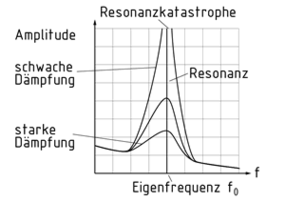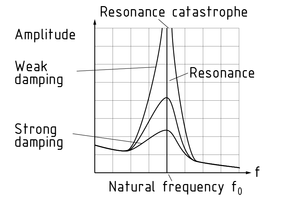
Choose one
or multiple languages
0,1,1
- German
- English
- Chinese
- Spanish
Natural frequency

In an engineering context, natural frequency is the frequency at which oscillatory systems with a moving mass and a single Degree of freedom of movement oscillate after one-time excitation. The system always oscillates in characteristic natural frequencies of the first and higher orders.
If a drive imposes periodic oscillations close to the natural frequency on such a system, the system reacts with particularly high amplitudes. The drive transfers energy to the system with each Oscillation, which means the amplitude also increases with each oscillation. In the case of an undamped oscillatory system, Resonance can lead to an unbridled increase in amplitude (resonance catastrophe).
If, by contrast, the drive frequency is lower than the natural frequency, the drive dictates the amplitude. If the drive frequency is higher than, and in opposition to, the natural frequency, the amplitude gets ever lower as the frequency increases beyond the resonance point.
Vibration absorbers can prevent the damage that can be caused by resonance. Changing the mass can also influence the natural frequency.
Eigenfrequenz

Die Eigenfrequenz ist die Frequenz, mit der technische Schwingsysteme mit einer bewegten Masse und einem Freiheitsgrad der Bewegung nach einer einmaligen Anregung schwingen. Dabei schwingt das System immer in charakteristischen Eigenfrequenzen erster und höherer Ordnung.
Wenn einem solchen System durch einen Antrieb periodische Schwingungen in der Nähe der Eigenfrequenz aufgezwungen werden, reagiert das System mit besonders großen Amplituden. Der Antrieb überträgt dabei mit jeder Schwingung Energie auf das System, so dass auch die Amplitude bei jeder Schwingung wächst. Bei einem ungedämpften schwingfähigen System kann die Resonanz zum grenzenlosen Anstieg der Amplitude (Resonanzkatastrophe) führen.
Ist die Antriebsfrequenz dagegen kleiner als die Eigenfrequenz, wird die Amplitude vom Antrieb vorgegeben. Ist die Antriebsfrequenz größer als die Eigenfrequenz und gegenphasig ausgelenkt, wird die Amplitude bei zunehmender Frequenz oberhalb der Resonanzstelle immer geringer.
Schwingungstilger können Schäden vermeiden, die durch Resonanz entstehen können. Auch durch die Veränderung der Masse kann die Eigenfrequenz beeinflusst werden.
固有频率

从工程角度来讲,固有频率 是指某个运动物体在单自由度状态下,受到一次激发后发生振荡的振荡频率。任何系统的振荡都是在一阶和高阶特征固有频率下发生的。
如果针对上述系统持续施加一个外力,并利用该外力以接近其固有频率的周期,来不断向系统输入能量,那么该外力将会在该系统产生特别高的振幅。在这种情况下,外力的每次振荡都会向系统输入能量,这也就意味着系统在每次振荡情况下,振幅都会随之而增加。在振荡系统无阻尼的情况下,会发生共振,而共振则会导致振幅幅度的增加失去控制(共振灾难)。
与上述相对照的情况是,如果外力频率比固有频率低,那么系统的振幅将决定于外力的大小。在相反的情况下,如果外力频率比固有频率高,由于频率超过了共振频率,这时候,系统的振幅将会越来越低。
减震器可以防止系统中出现共振,从而避免共振引起的损害。改变系统的质量也可以对固有频率产生影响。
固有频率,阻尼和共振
近义词
共振频率
Frecuencia natural

En un contexto de ingeniería, la frecuencia natural es la frecuencia en la cual los sistemas oscilatorios con una masa móvil y un solo grado de libertad de movimiento oscilan después de una excitación única. El sistema siempre oscila en frecuencias naturales características del primer orden y superiores.
Si una transmisión impone oscilaciones periódicas cerca de la frecuencia natural en dicho sistema, el sistema reacciona con amplitudes particularmente amplias. La transmisión transfiere la energía al sistema con cada oscilación, lo que significa que la amplitud también se incrementa con cada oscilación. En el caso de los sistemas oscilatorios sin amortiguamiento, la resonancia puede generar un incremento desbocado en la amplitud (catástrofe de resonancia).
Si, en contraste, la frecuencia de transmisión es menor a la frecuencia natural, la transmisión dicta la amplitud. Si la frecuencia de transmisión es mayor que, y opuesta a, la frecuencia natural, la amplitud baja aún más al incrementarse la frecuencia más allá del punto de resonancia.
Los amortiguadores de vibración pueden prevenir el daño que puede ser causado por la resonancia. Cambiar la masa también puede influenciar la frecuencia natural.
Frecuencia natural, amortiguamiento y resonancia
